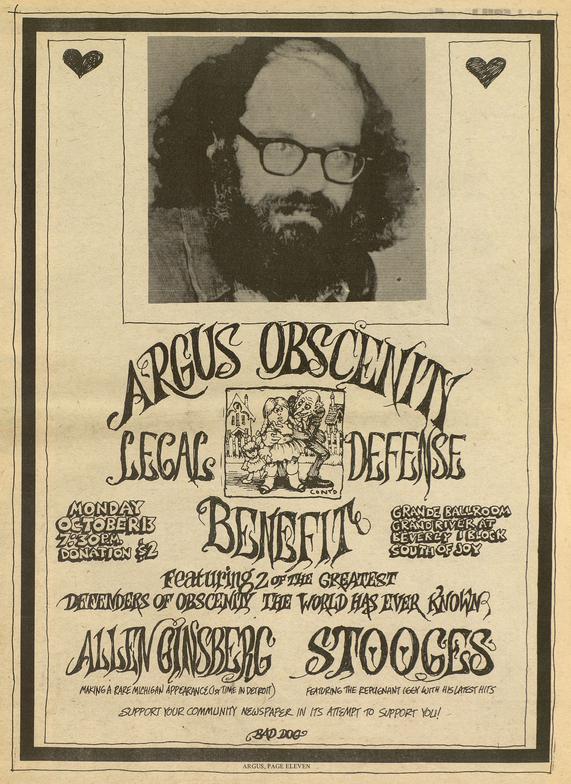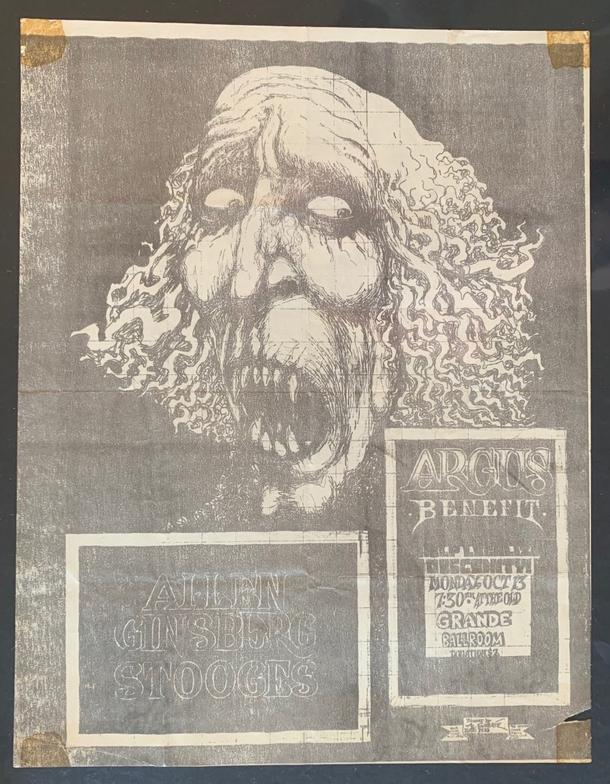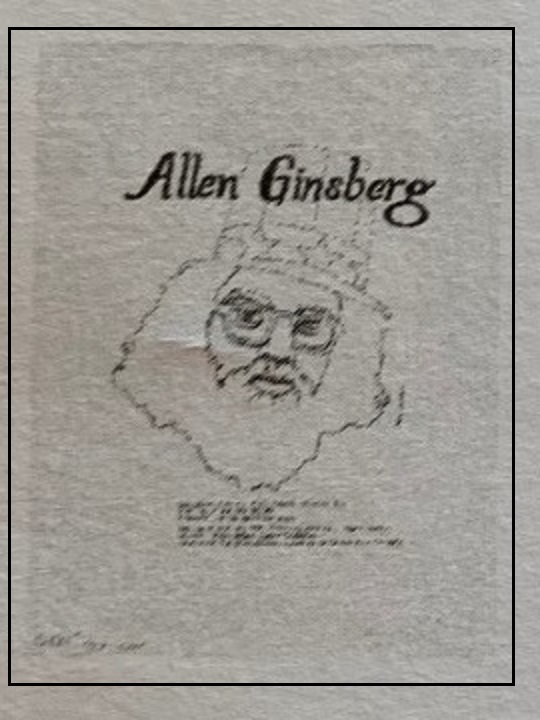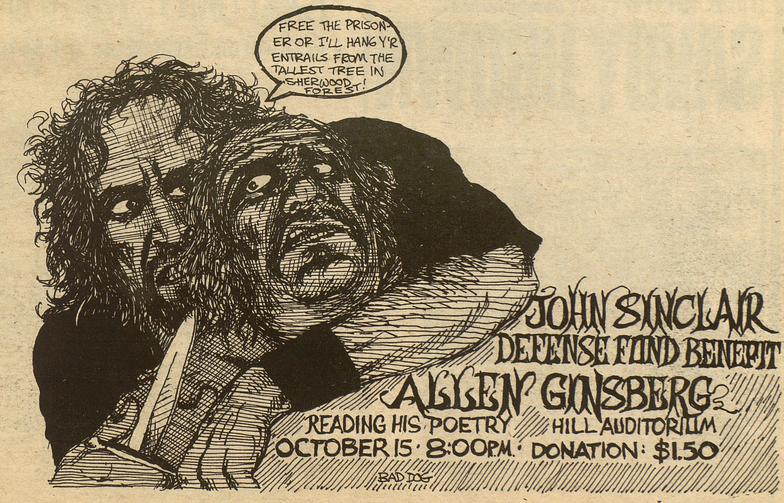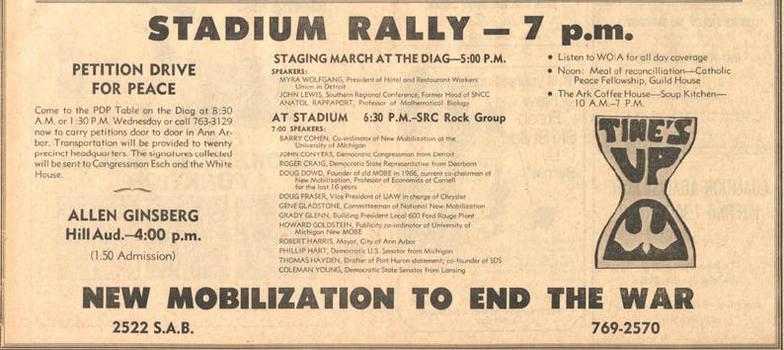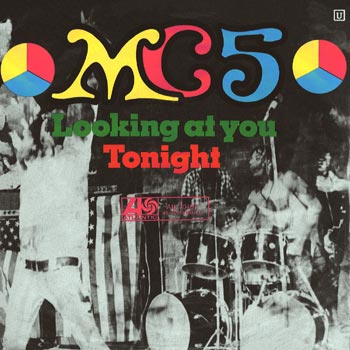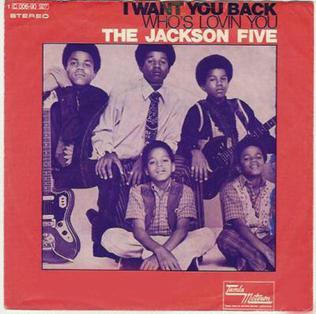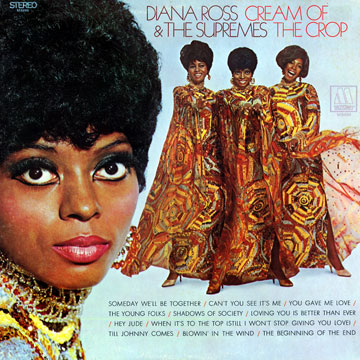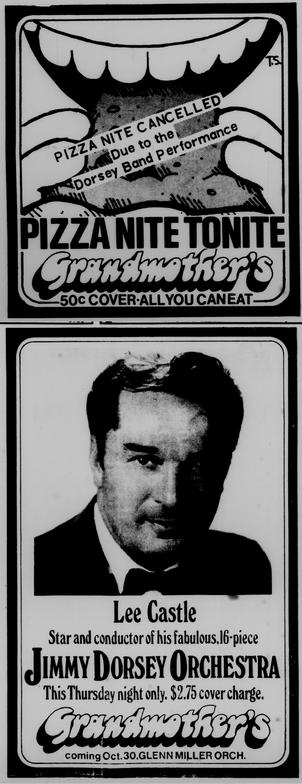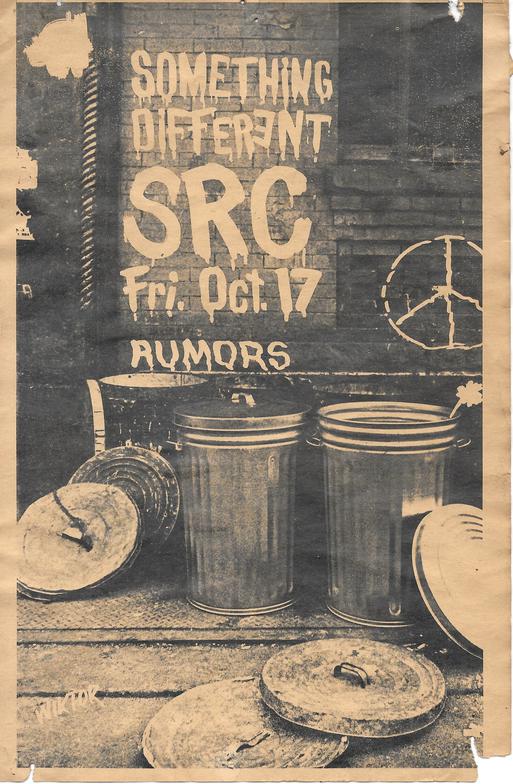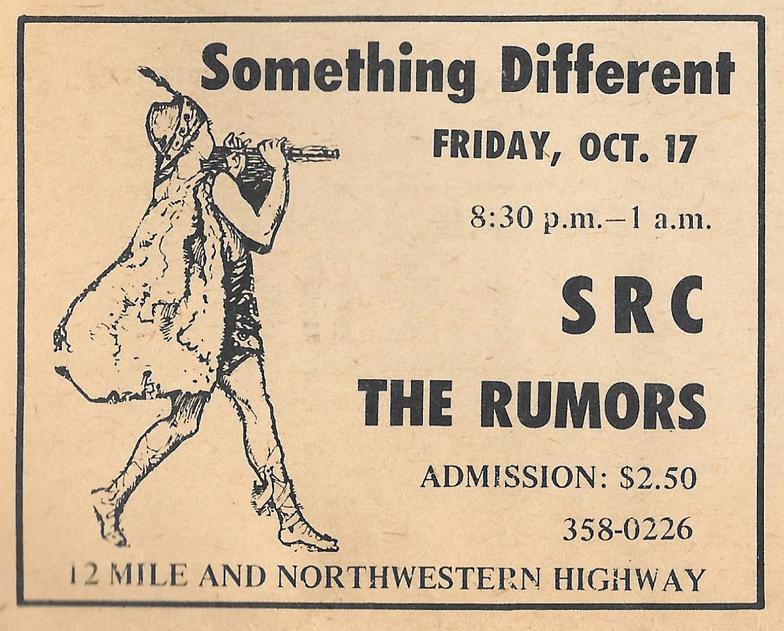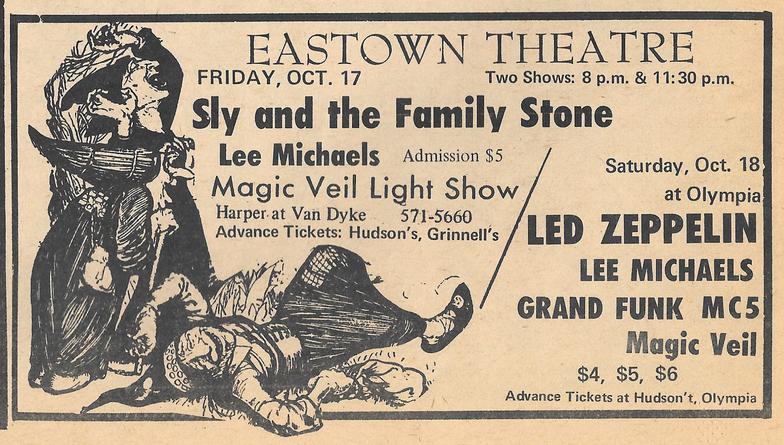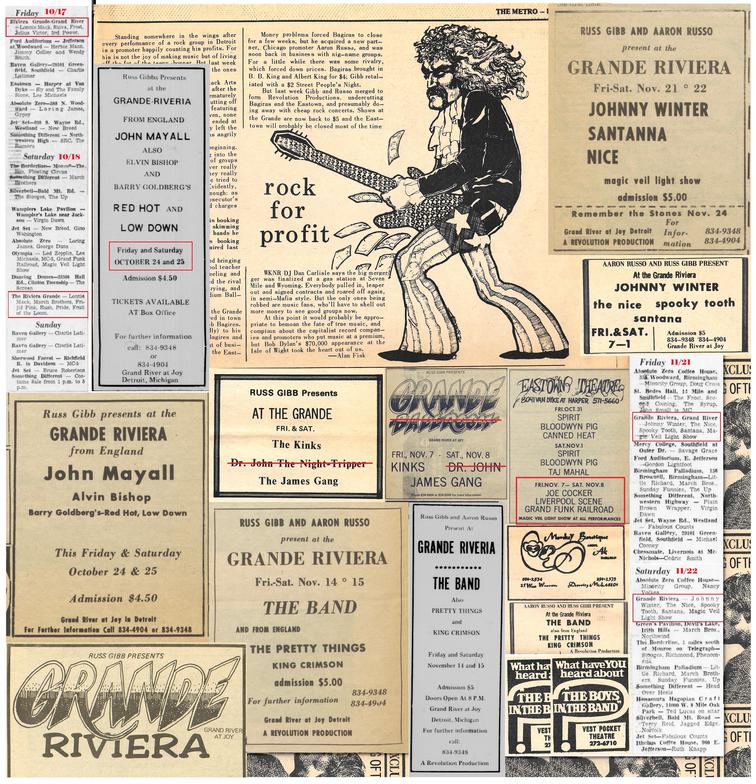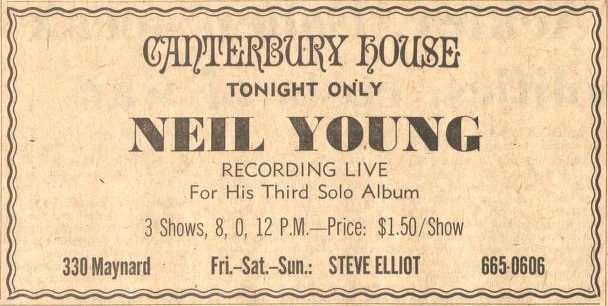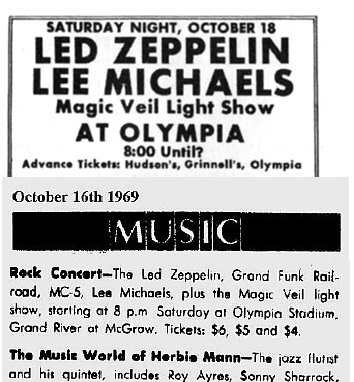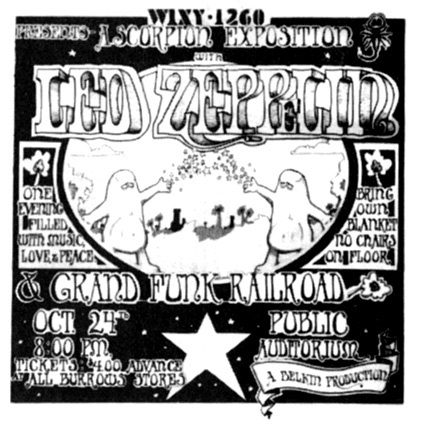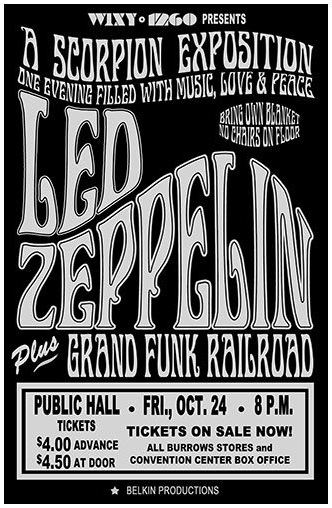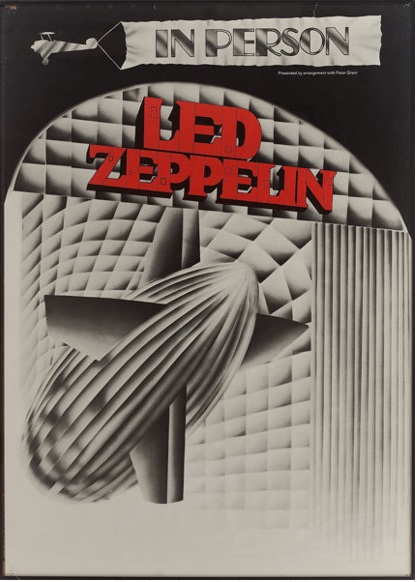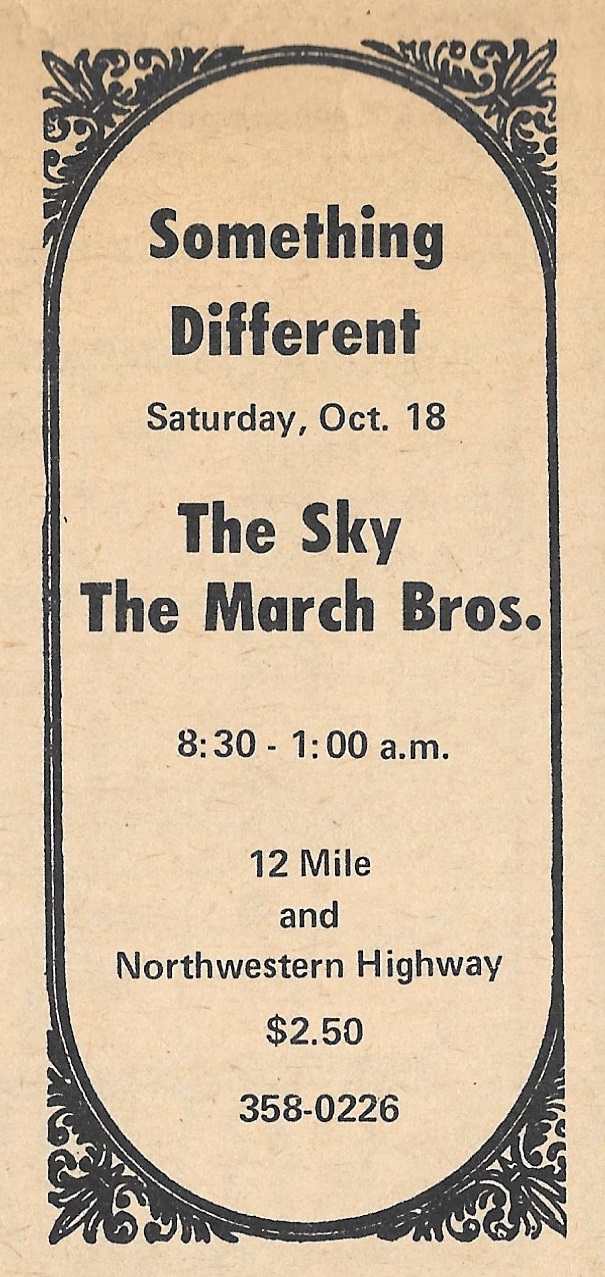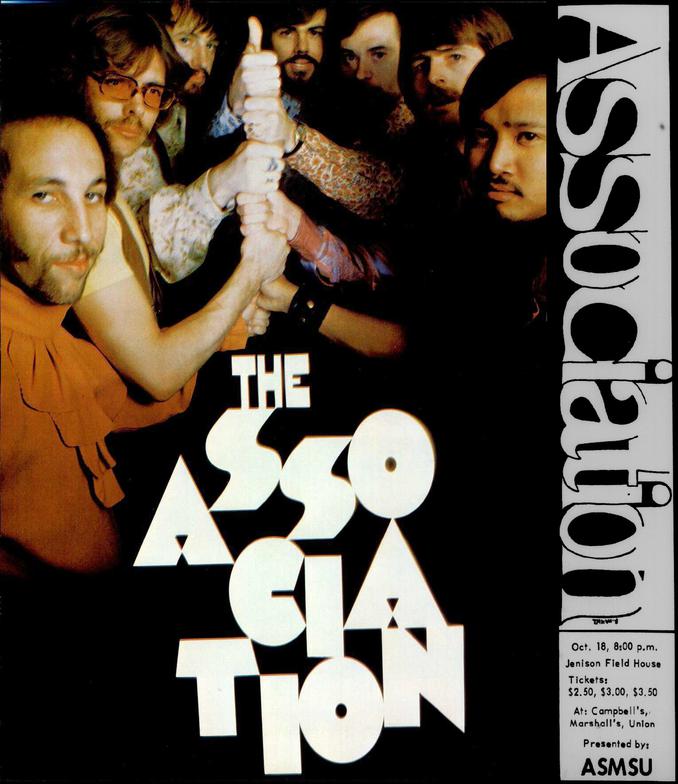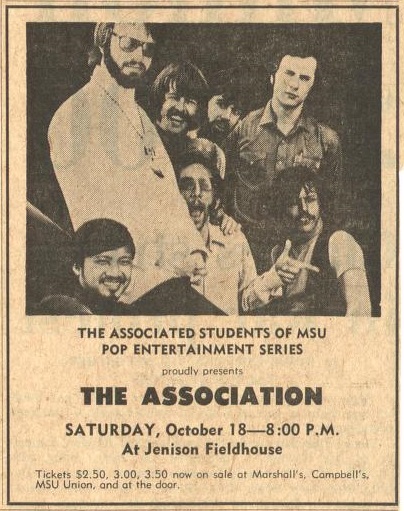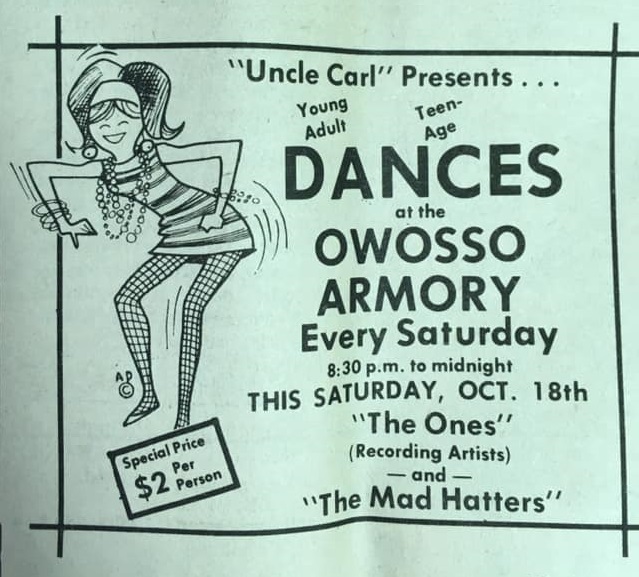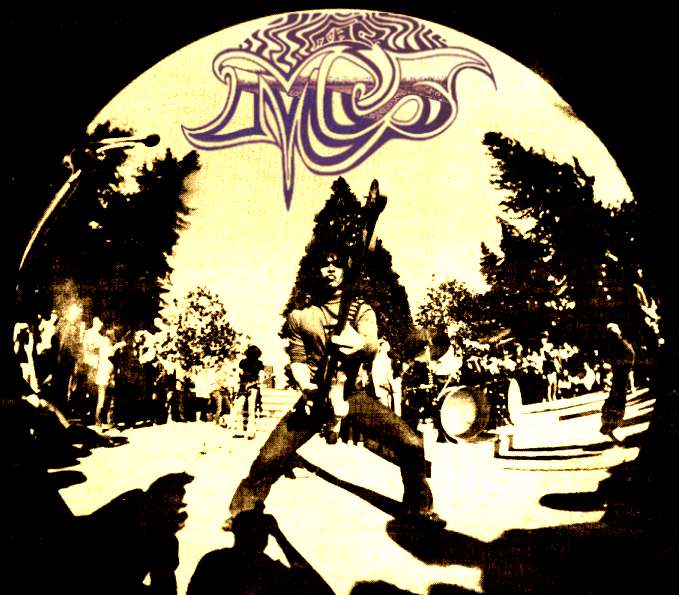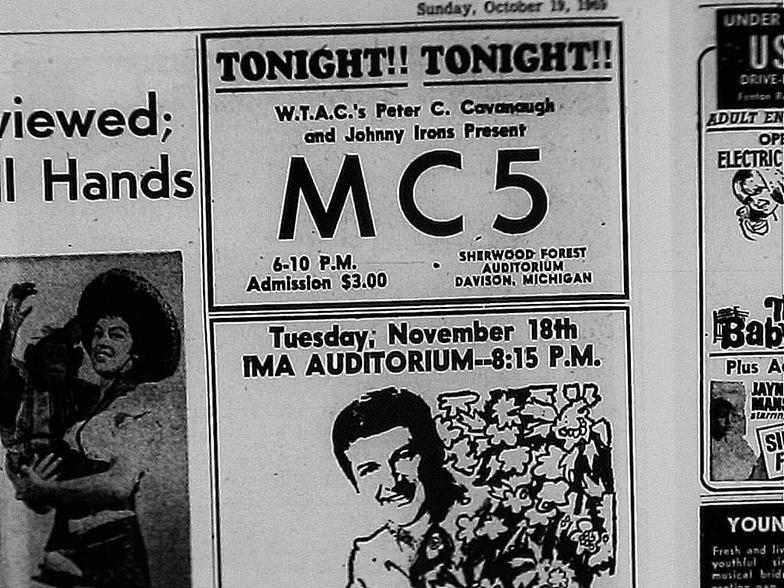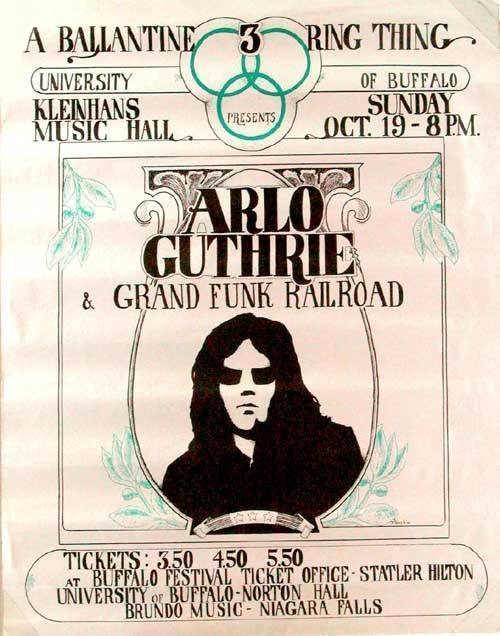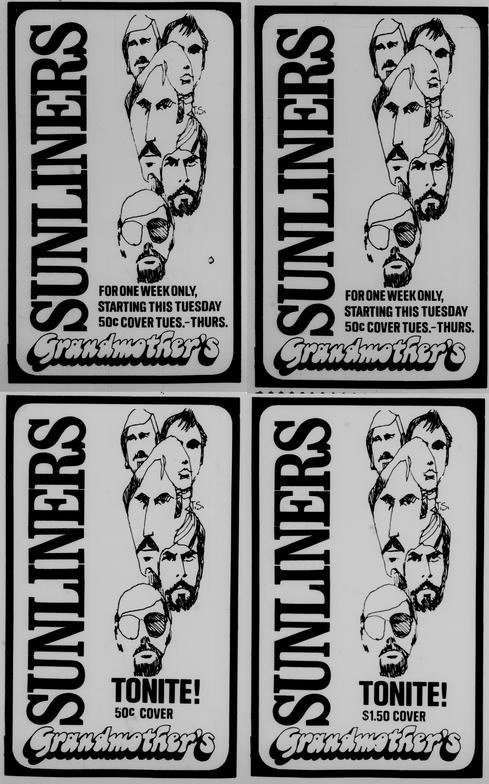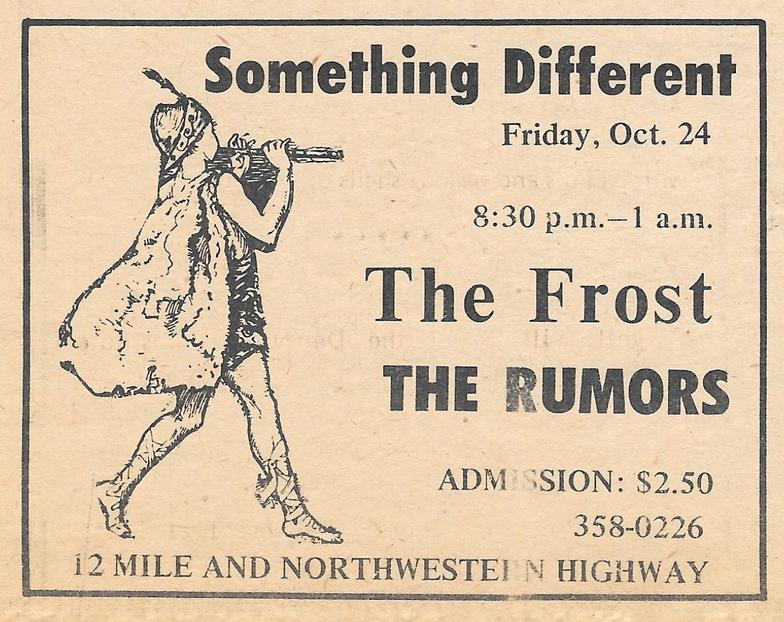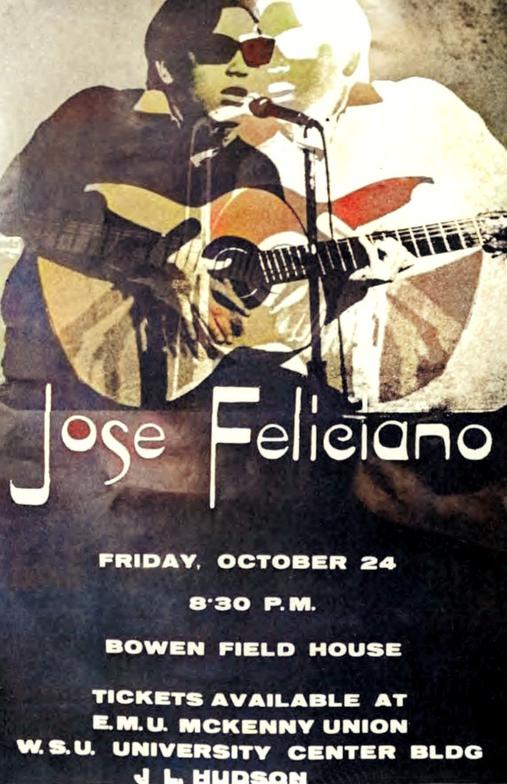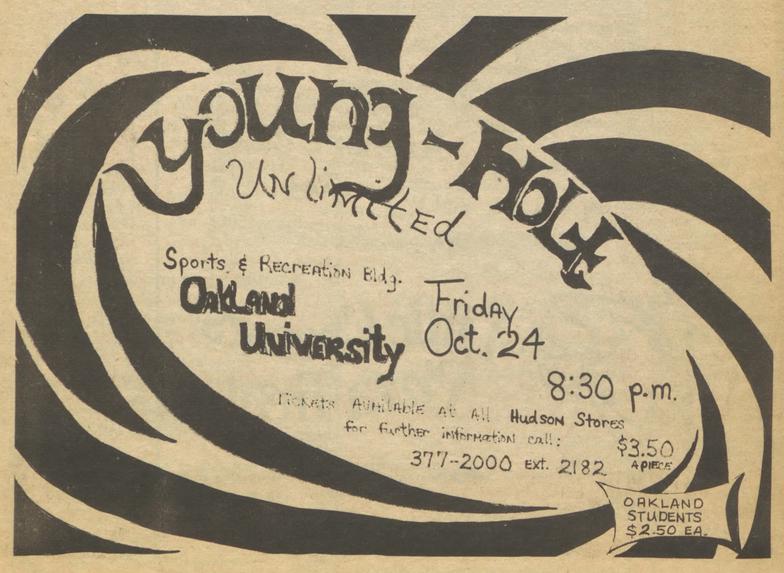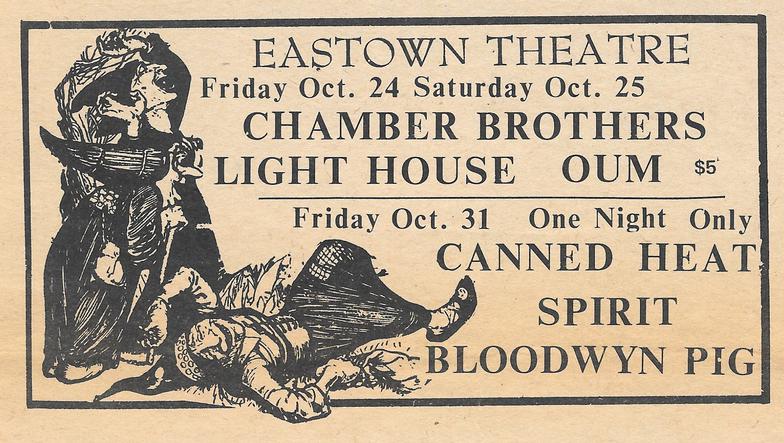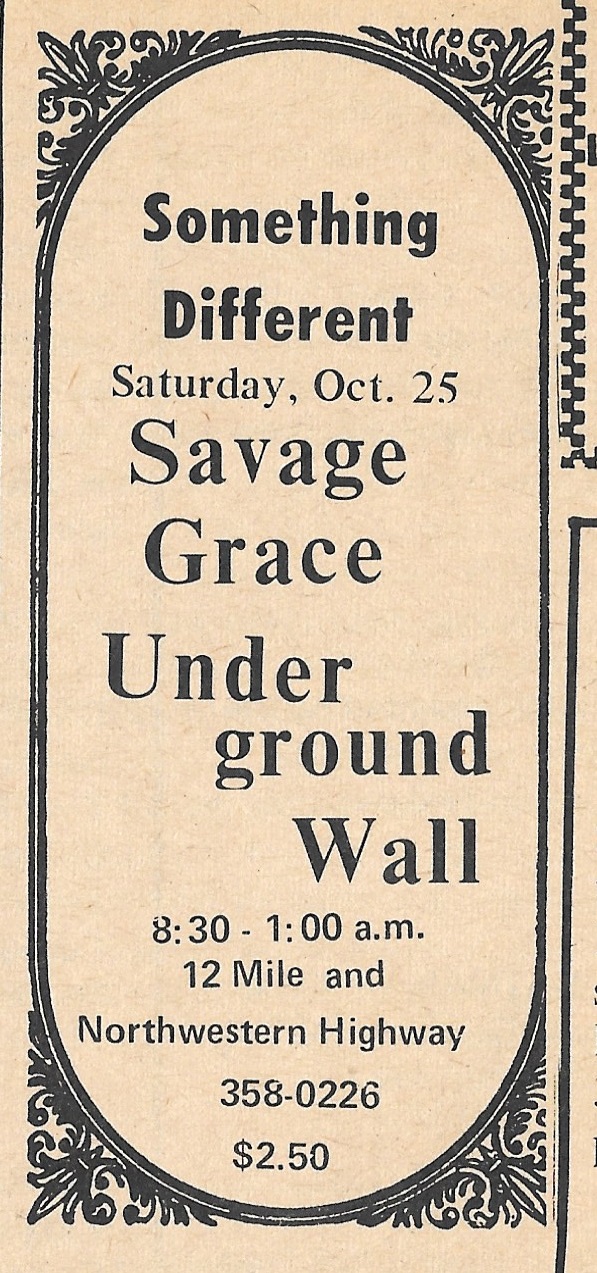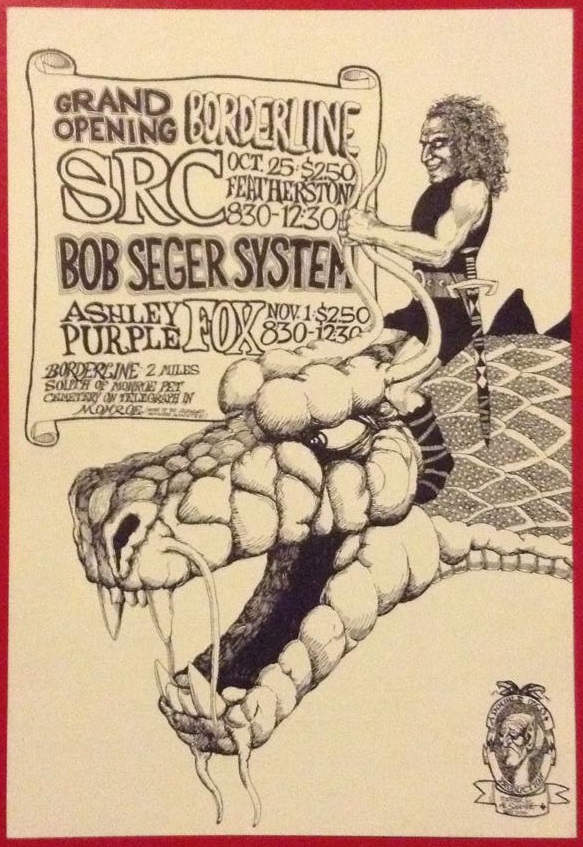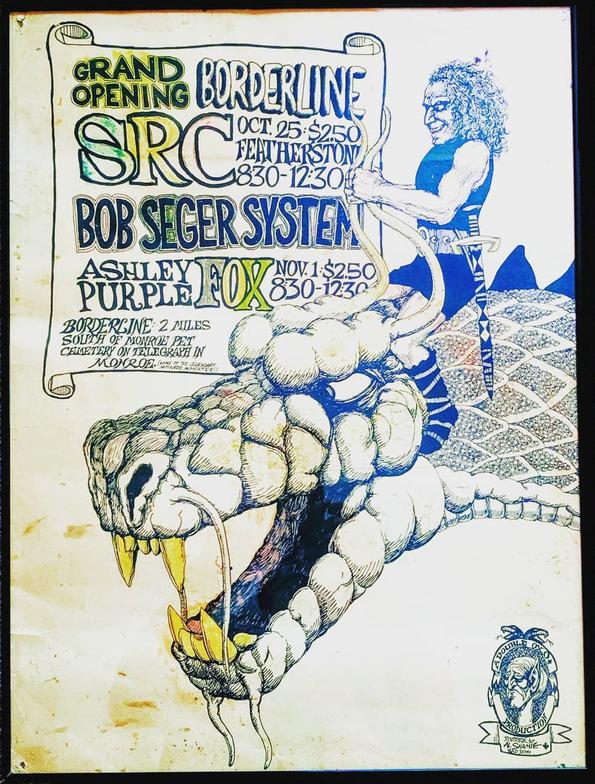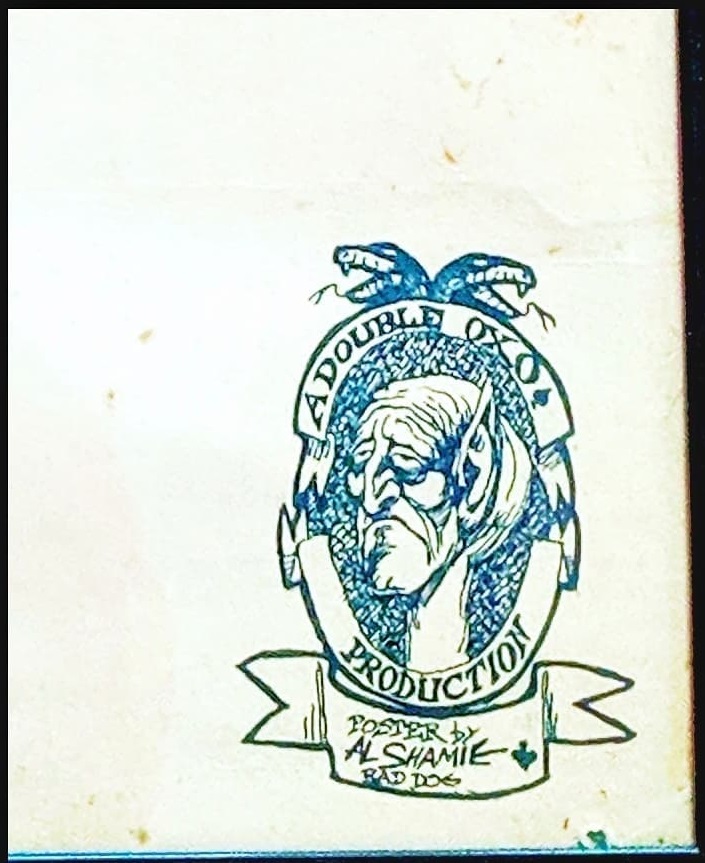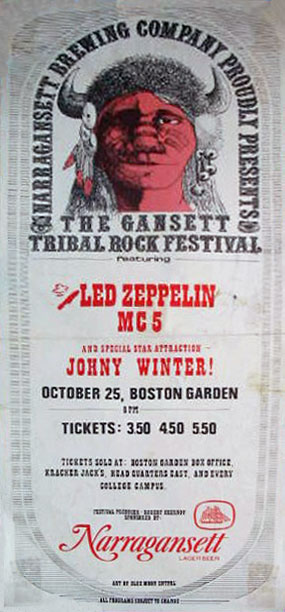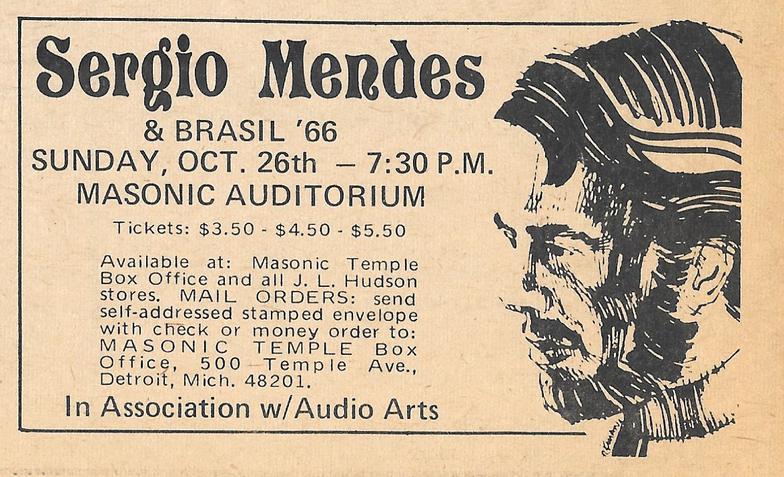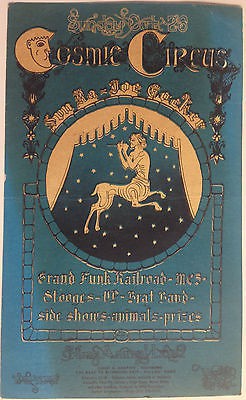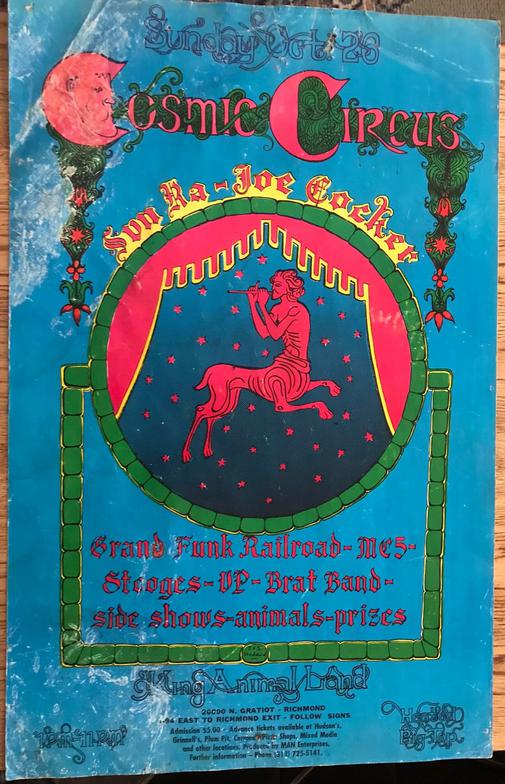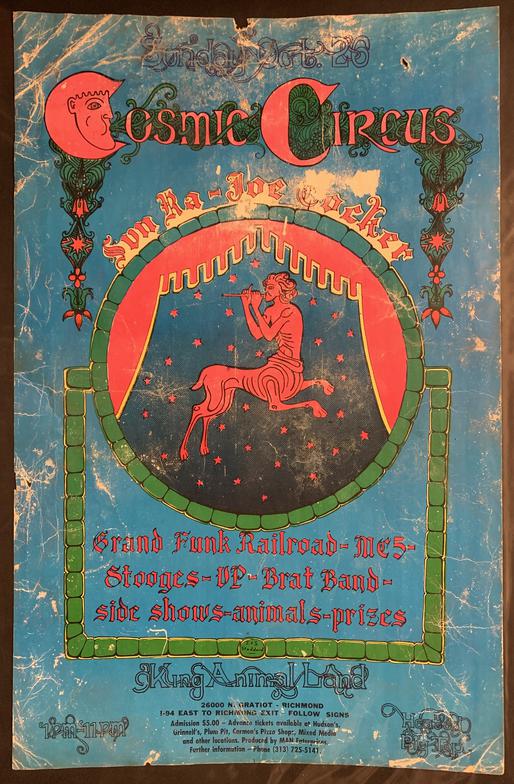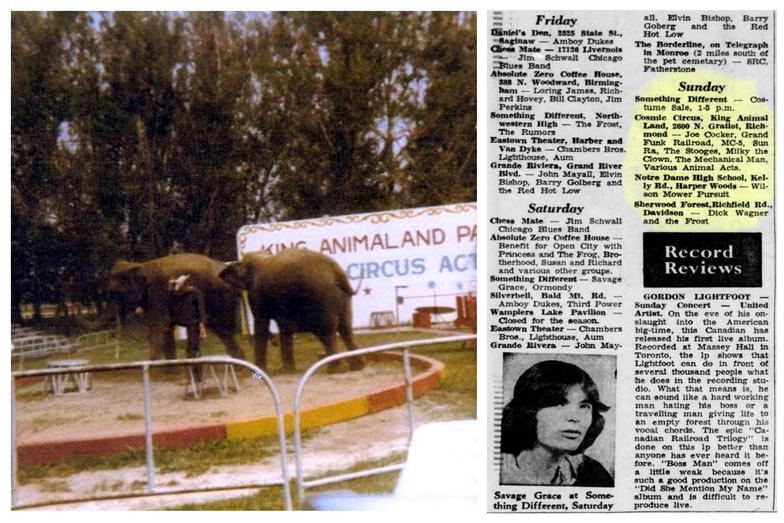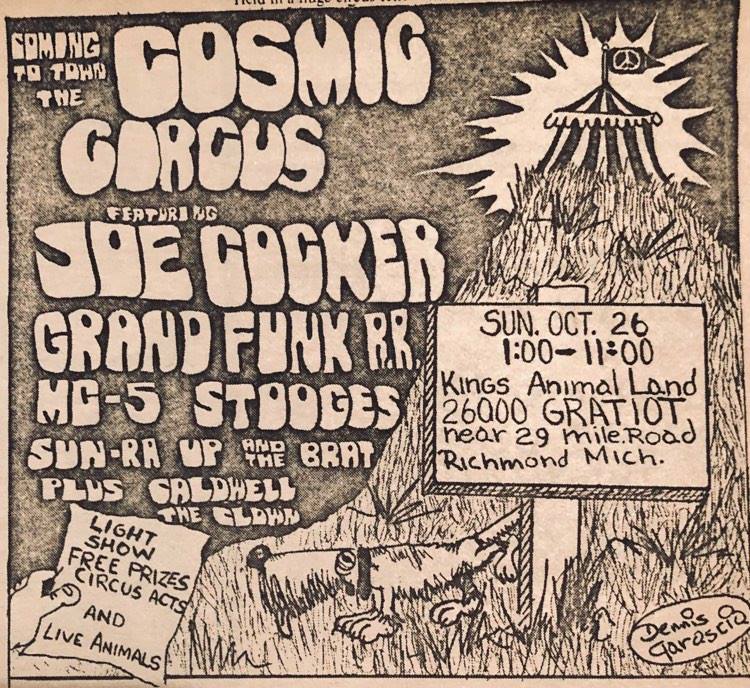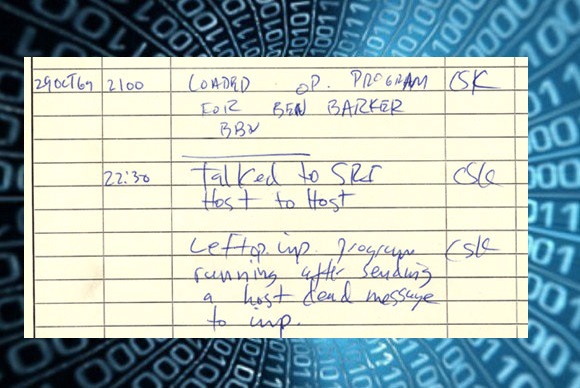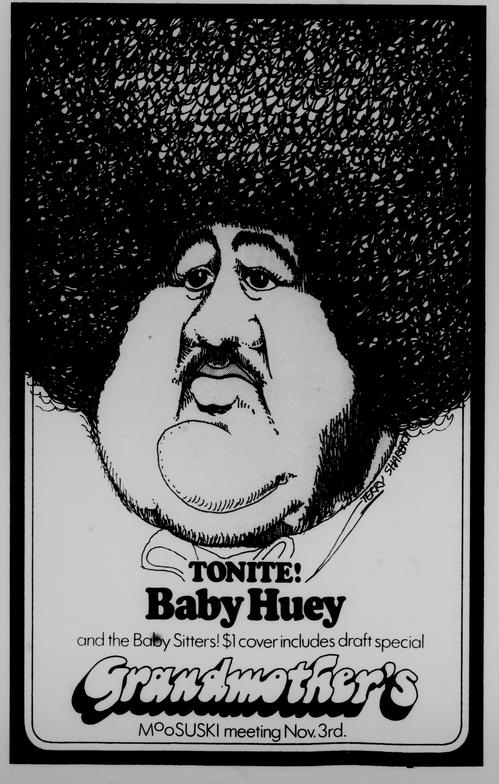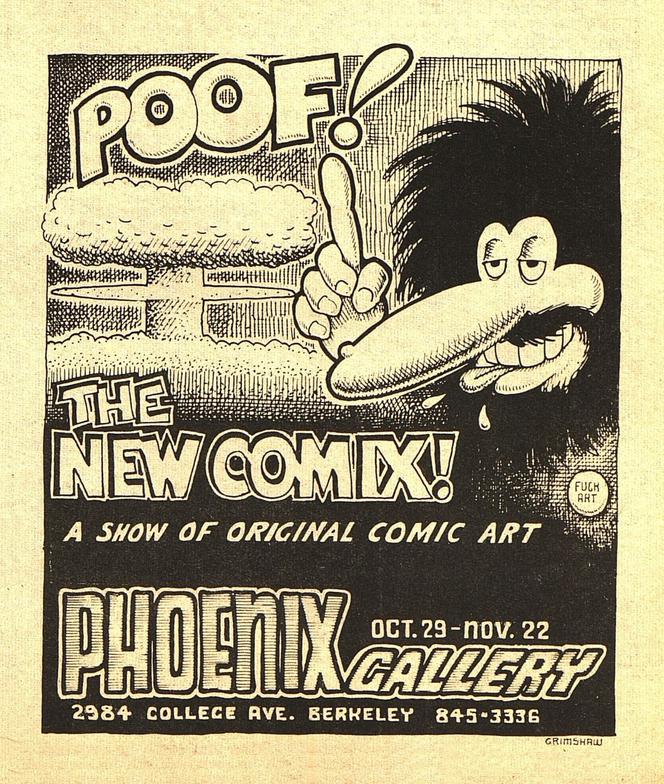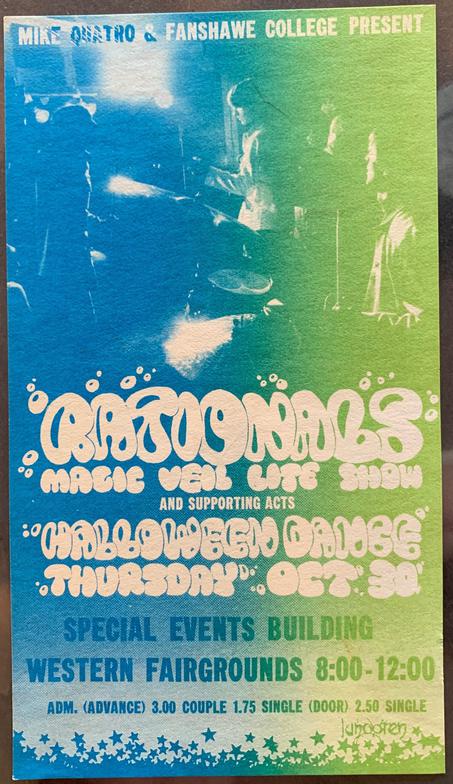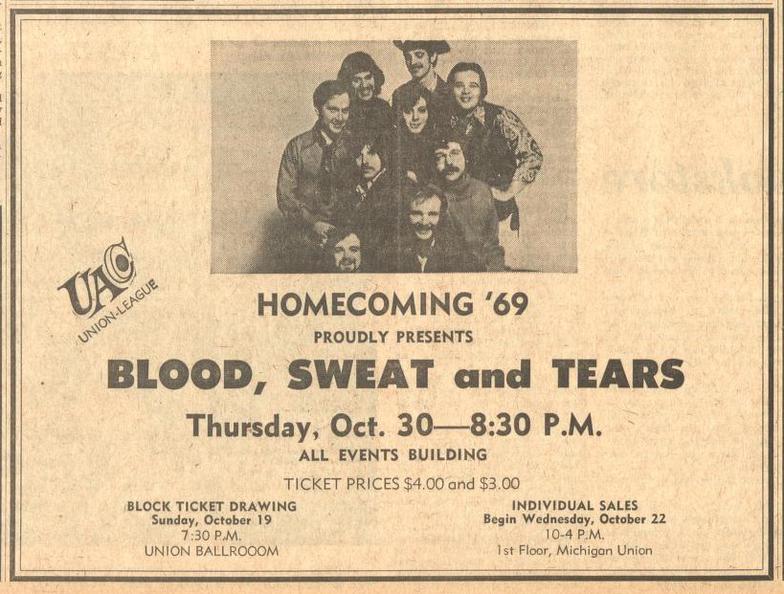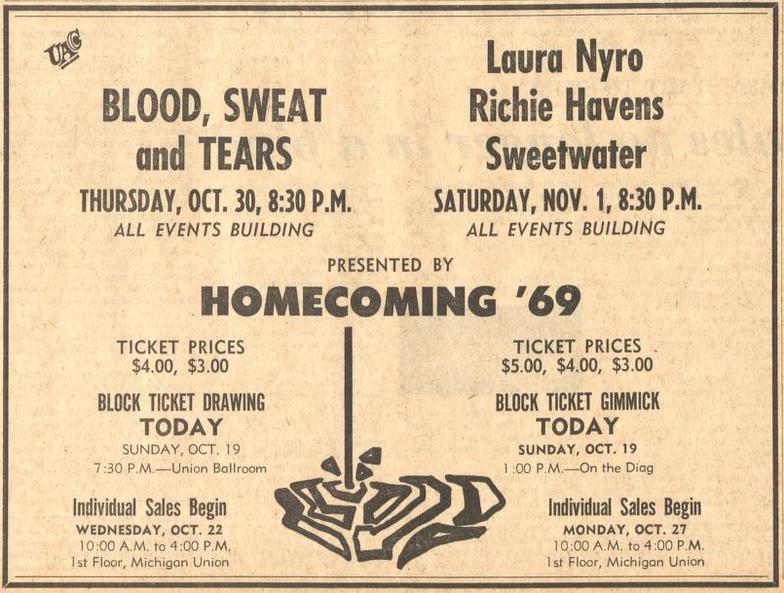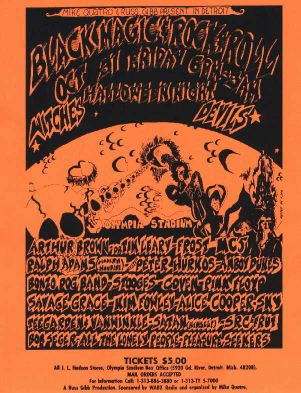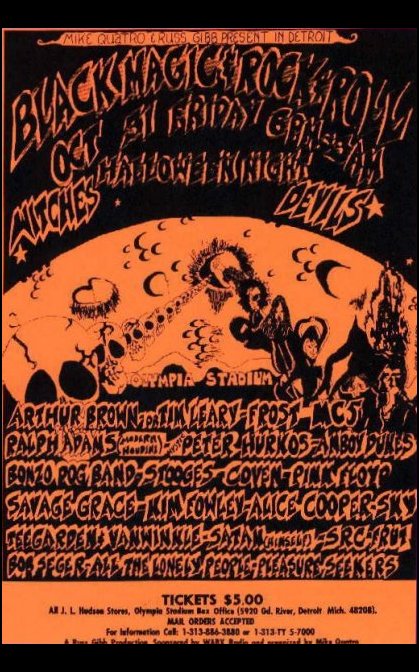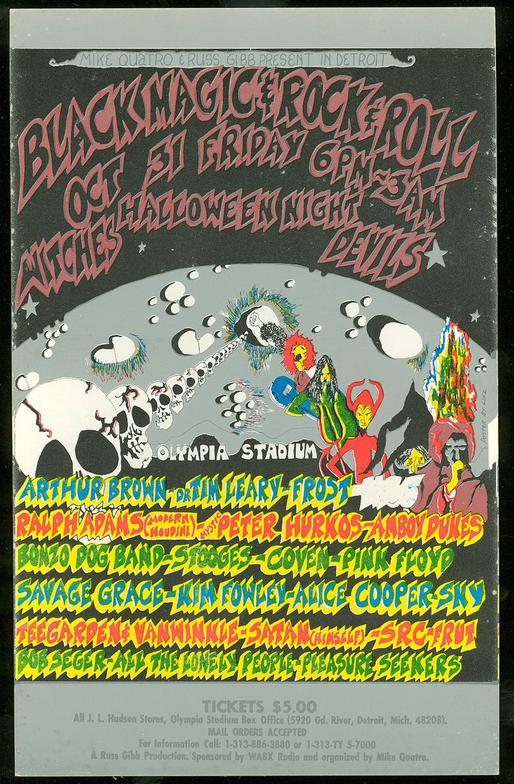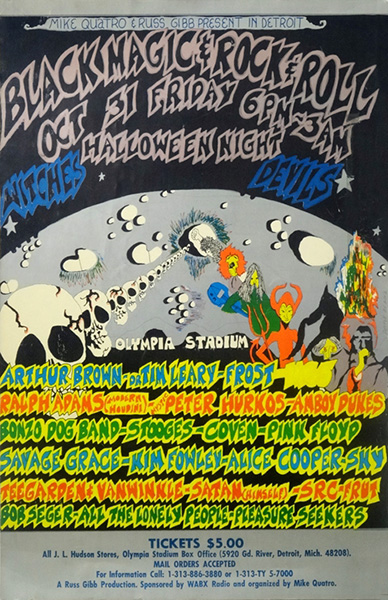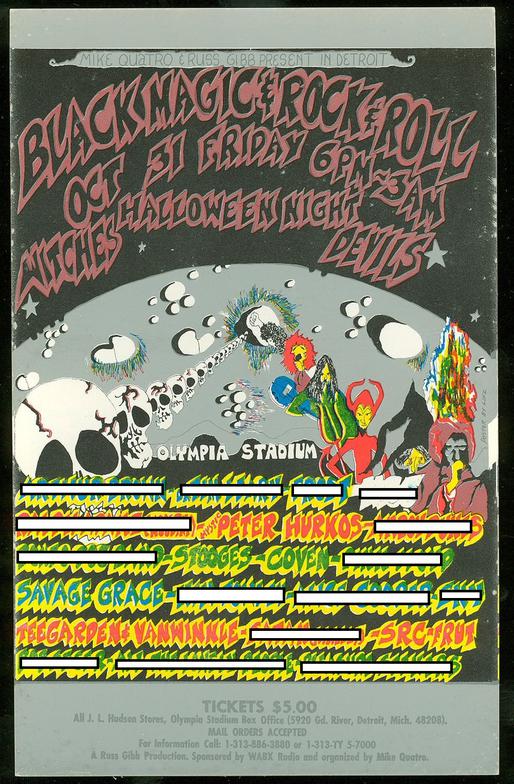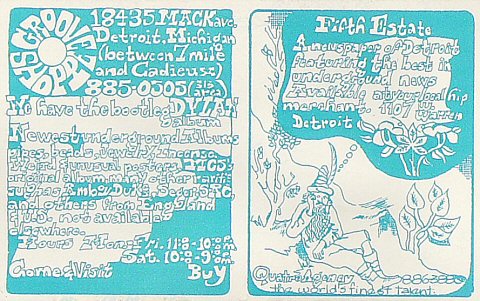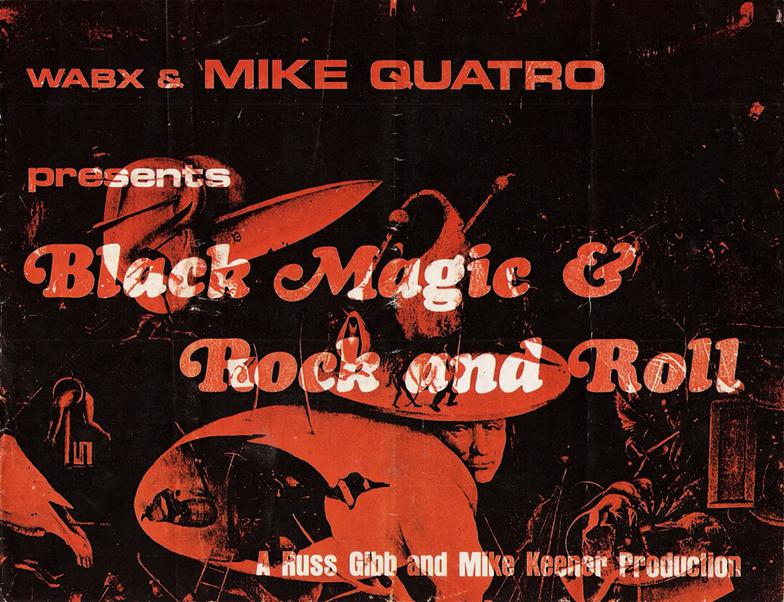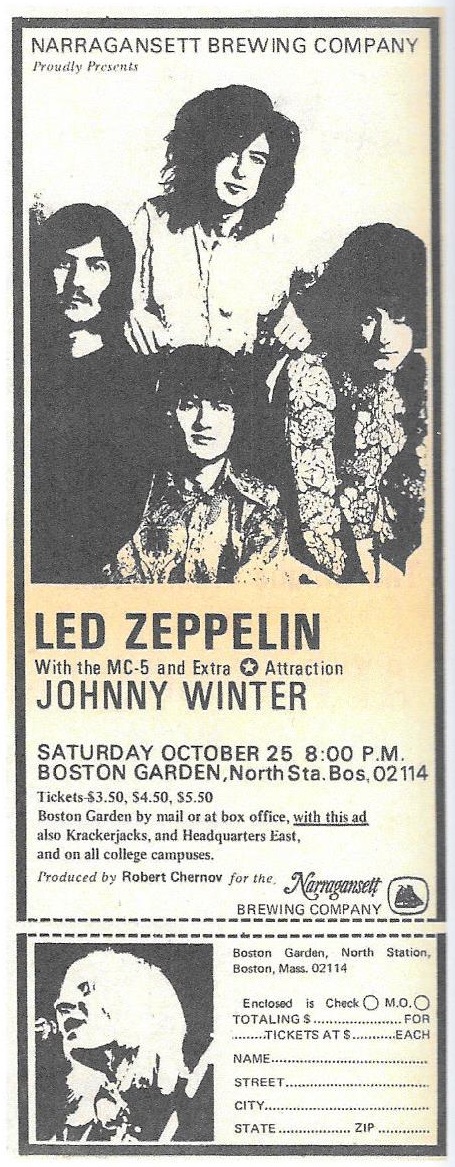Splatt Gallery
Double click here to add text.
Splatt Gallery's History of Michigan Concert Posters
Volume Five - 1969 - Page Twenty
**********************************************************
A benefit show at the Grande Ballroom on October 13, 1969 to raise funds for the defense of the Ann Arbor Argus newspaper against obscenity charges, featuring “two of the greatest defenders of obscenity”, poet Allen Ginsberg and the Stooges. Full-page ad by Al Shamie (Bad Dog).
Poster/flyer by Al Shamie (Bad Dog) for the Ann Arbor Argus newspaper benefit show at the Grande Ballroom in Detroit, Michigan on October 13, 1969 featuring poet Allen Ginsberg and the Stooges.
An unfortunately tiny image of a poster by J&S Stoddard for the benefit show for the Ann Arbor Argus newspaper at the Grande Ballroom in Detroit, Michigan on October 13, 1969, featuring poet Allen Ginsberg and the Stooges. The poster measures 16” x 21”.
It appears that Allen Ginsberg hung out in Michigan for a few days after the benefit show at the Grande Ballroom on October 13, 1969. This advertisement by Al Shamie (Bad Dog) is for an appearance at Hill Auditorium in Ann Arbor two days later, October 15, 1969.
The SRC rock group also performed at Michigan Stadium in Ann Arbor as part of the program that featured Allen Ginsberg’s appearance on October 15, 1969, also featuring then-State Senator, Coleman Young.
Over the summer, the MC5 had finished the recording of their second album, their first for Atlantic Records, produced by Jon Landau.
The first single was released in early October, the A-side was a remake, with nowhere near the power, of their 1968 single , the B-side was a passable tune, but there was something really off, “OK kids, it’s rockin’ time” is cringe worthy.
MC5 – Tonight (1969)
https://www.youtube.com/watch?v=nm5PE31w2sk
Released during the same week as the MC5’s first Atlantic single, the first Jackson Five single was also released. Two singles by the two fives.
In retrospect, the J5 were the official passing of the Motown crown, coinciding with the end of the decade and the split of Diana Ross from the Supremes, the sixties turned into the seventies.
“I Want You Back” became the group’s first #1 single in January 1970, the first of what would become four #1 singles in a row.
The Jackson Five – I Want You Back (1969)
https://www.youtube.com/watch?v=SA3-mVGc8wA
The turn of the decade neatly marked the passage of the Motown torch from the Supremes to the Jackson Five. It was announced in November, 1969, that Diana Ross would leave the group to pursue a solo career and the final studio album, Cream of the Crop, was released mainly to get their final #1 hit single, the poignantly timely “Someday We’ll be Together” onto an LP.
The group performed its final concert together on January 14, 1970 at the Frontier Hotel in Las Vegas. Nine years after emerging from the Brewster Projects in Detroit, with twelve #1 singles, three #1 albums, countless television appearances and sold-out concerts around the world, the Supremes, and the Sixties, were over.
Diana Ross & the Supremes – Someday We’ll be Together (live 01/14/70)
https://www.youtube.com/watch?v=x0d2ih2Y9C0
An unusual booking with an ad by an unknown artist for Grandmother’s in East Lansing, Michigan, a party spot for rock and soul acts, they brought the Jimmy Dorsey Orchestra to town on October 16, 1969. They even cancelled Pizza Nite in deference to the high-class swing, and appear to making a habit of it, with the Glen Miller Orchestra coming October 30th.
Poster by Wiktor, aka Ken Victor, for SRC with Rumors at Something Different in Southfield, Michigan on October 17, 1969.
Newspaper ad for SRC with the Rumors at Something Different in Southfield, Michigan on October 17, 1969.
A rare print ad for the Eastown Theatre in Detroit, Michigan, with Sly & the Family Stone and Lee Michaels appearing on October 17, 1969. The ad also notes the show by Led Zeppelin, Lee Michaels, Grand Funk and MC5 at the Olympia Stadium in Detroit for the following night.
The above collage of shows at the Grande Riviera in October/November 1969 is a good visualization of the puzzle of the venue’s short tenure. The story in The Metro entertainment newspaper with the illustration by Al Shamie (Bad Dog) described the entanglements of promoters Russ Gibb, Bob Bageris, and Aaron Russo, and the situation was confusing.
To make a long story short, it appears that there were five weekend shows at the Grande Riviera following the Grand Opening weekend of October 10-12, 1969. The list would be:
- Lonnie Mack – October 17-18
Lonnie Mack – October 17-18
- John Mayall – October 21-22
John Mayall – October 21-22
- Kinks, Joe Cocker, James Gang, Grand Funk Railroad – November 7-8
Kinks, Joe Cocker, James Gang, Grand Funk Railroad – November 7-8
- The Band – November 14-15
The Band – November 14-15
- Johnny Winter – November 21-22
Johnny Winter – November 21-22
Newspaper ad for Neil Young at the Canterbury House in Ann Arbor, Michigan on October 17-19, 1969. The ad states that he would be recording the show intended for his third solo album, but those plans were shelved when his third album, “After the Gold Rush” was released in 1970.
In 2008, as part of his Archive Series releases, Young released “Sugar Mountain – Live at the Canterbury House”, but the recordings were taken from his prior engagement at the club in November 1968.
Led Zeppelin returned to Detroit for their third visit of the year, October 18, 1969, by this time their popularity had outgrown the Grande Ballroom and Russ Gibb booked them at the Olympia Stadium. Ticket sales still were slow, so a week before the show two acts were added to the line-up, the MC5, who were now label mates with Zeppelin, both on Atlantic Records, and Grand Funk Railroad who had just been signed to legendary Frank Barsalona’s Premier Talent agency, who was also the agent for Led Zeppelin. The expanded bill worked and they sold capacity.
This is the show that, in the lore of GFR, was the night that Grand Funk “blew Led Zeppelin off the stage” and were kicked off the tour by the up-staged Brits.
Or at least that's how Terry Knight and members of the band have recounted it many times, that GFR was rocking the Olympia harder and louder than Zeppelin knew they could ever hope to match, and that notorious Zeppelin manager Peter Grant hoisted Knight off his feet by the neck, cut the power to the stage, prompting an audience riot.
Out in the blogosphere there is a complete song-by-song account of all four acts that night and although the author's credibility is strained by the end of the blog, there are many points made that seem more in the reality of the way these large rock shows took place. As mentioned, the bill expanded from two acts to four, with the same 8:00pm start time, and with the typical delays by the time GFR, third on the bill, started.it was already close to their scheduled end time. The show was facing a curfew that meant there may not be time left for Zeppelin to go on, potentially forfeiting their fee, so GFR were asked to keep it short. Getting into the spirit of the moment, and, admittedly, enjoying a great audience reaction, they started into another song after their agreed ending, so Russ Gibb did interrupt the act and explained that they needed to get Zeppelin on before the curfew. No plugs were pulled, no riots happened, Zeppelin took the stage in the short time it took to set up their equipment and they completed their set, albeit past curfew, the threat of bodily harm was probably over-exaggerated, and both bands had bookings made far in advance that did not change, in fact GFR performed again with Led Zeppelin six days later in Cleveland, they were not “kicked off” any “tour”.
But such was the genius of Terry Knight.
https://www.thegearpage.net/board/index.php?threads/led-zeppelin-and-grand-funk-railroad-10-18-69-olympia-stadium-the-shut-down.1632839/
Yes, the genius of Terry Knight created much of the lore of the Grand Funk Railroad's earliest appearances, that they would show up not on the bill for a festival and offer to play for free (they did), and that they would proceed to blow away the headlining act (they did not), and be invited to come back the next day to headline in their place (didn’t happen).
The claim that they were kicked off the Led Zeppelin "tour" because they blew Zeppelin away at the October 18, 1969 show in Detroit is refuted by this poster, and show reviews, from Cleveland just six days later. During the days in between those shows, GFR was booked in their Cleveland recording studio working on their second album.
Nevertheless, things continued to fall into place for Terry Knight, as he was indeed getting them onto large stages, had secured a second album for them with Capitol Records, and also got them signed with the Premier Talent booking agency, all high-level accomplishments which probably only increased some of the resentment towards the band in the local music circles.
So far in this narrative, we have featured four songs by Terry Knight, most of them fairly wretched, and that's even purposely avoiding the even worse "hits", but leave it to Head Druid Julian Cope to manage to find the best of anything and he found these two Terry Knight & the Pack tracks that are actually pretty good.
Terry Knight & the Pack – How Much More (1965)
https://www.youtube.com/watch?v=afeM1SbRfbM
Terry Knight & the Pack – Numbers (1966)
https://www.youtube.com/watch?v=uZg0CLG9HSI
Not to beat a dead horse that this poster disproves the myth that Grand Funk Railroad “blew Led Zeppelin off the stage in Detroit” on October 18, 1969, and that they were “kicked off the tour” in retaliation, this poster from six days later shows GFR again opening for Zeppelin and introduces us to the Cleveland poster artist known as Bear.
Starting out as “just a way to make some weed and beer money”, it is estimated that Bear has made over 6,000 posters for Cleveland and area shows, and remains currently active, running the Raw Sugar Art Studio, which can be found here:
https://rawsugarstudio.com/
A 1969 tour-blank poster for Led Zeppelin, which could have been used for some of the six shows that Led Zeppelin played in Detroit that year, there were three in January, two in May, and one in October.
Newspaper ad for Sky with the March Brothers at Something Different in Southfield, Michigan on October 18, 1969.
Ad by Robert Daniel for an appearance by The Association at the Jenison Field House in East Lansing, Michigan, October 18, 1969 with a full-page promo shot of the band from Billboard magazine a few months prior to this show.
Over the years, beginning in 1965, the band has had dozens of members pass through their ranks. They came out strong, with a handful of #1 hits and gold records in their first two years, songs that were memorable enough to sustain the band to this day.
This clip from a 1967 appearance on the Smothers Brothers TV show is rather humorous.
The Association – Along Comes Mary (1966)
https://www.youtube.com/watch?v=sYJhhKSXOBo
Newspaper ad for the Association at the Jenison Field House in East Lansing, Michigan, October 18, 1969.
An ad for the Owosso Armory in Owosso, Michigan with The Ones appearing with The Mad Hatters on October 18, 1969.
Having pulled off successful preliminary Wild Wednesday and Super Sunday shows at the Sherwood Forest outside of Flint, Michigan, WTAC DJ Peter C. Cavanaugh had the perfect choice in mind for the band to play the Grand Opening of the new larger dance hall that owner Don Sherwood had just finished constructing on the property, the band was The MC5.
The date for the grand opening was set for October 19, 1969 and Cavanaugh came up with a theme for promoting the show as “The End of the World”, creating a sixty-second radio spot and, in his words, “killer ‘End of the World’ posters and flyers printed and circulated at every record store, bar, shopping mall and theater complex in a fifty-mile wide area”.
How on earth have we never seen one?
Not the poster we hoped for, but here is an ad for the MC5 at Sherwood Forest from the day of the show, October 19, 1969.
Here’s an odd pairing, on this poster by an unknown artist, with Grand Funk Railroad opening for Arlo Guthrie in Buffalo, New York on October 19, 1969.
Four ads by Terry Sharbach for the Sunliners at Grandmother’s in East Lansing, Michigan, October 21-25, 1969.
Newspaper ad for Frost with the Rumor at Something Different in Southfield, Michigan on October 24, 1969.
A very nice poster by an unknown artist for Jose Feliciano at Eastern Michigan University in Ypsilanti, Michigan on October 24, 1969.
A poster by an unknown artist for Young-Holt Unlimited at Oakland University in Rochester, Michigan on October 24, 1969.
A print ad for the Eastown Theater in Detroit, Michigan, with the Chamber Brothers, Light House, and Oum appearing October 24-25, 1969.
A print ad for the Something Different club in Southfield, Michigan, with Savage Grace and Underground Wall appearing on October 25, 1969.
Another grand opening, The Borderline in Monroe, Michigan, south of Detroit, down Telegraph Road.
From The Detroit Free Press: “Formerly The Club, the place is now called The Borderline and will be run by Al Nally and Rone Levine. The latter is a former equipment man for the MC-5.”
Poster by Al Shamie (Bad Dog) for the Grand Opening of the Borderline club in Monroe, Michigan, with SRC and Featherstone on October 25, 1969, and with the Bob Seger System, Ashley Purple and Fox on November 1st.
A close-up of Al Shamie’s logo on the Borderline poster.
The MC5 made a quick Saturday night trip to Boston to open for Johnny Winter and Led Zeppelin at the Gansett Tribal Rock Festival on October 25, 1969. The use of the word “festival” beginning to lose meaning.
A print ad for Sergio Mendes & Brazil 66 at Masonic Auditorium in Detroit, Michigan, on October 26, 1969.
The 19th festival of the year was held at King’s Animal Land Park, a petting zoo in Richmond, Michigan, October 26, 1969, called the Cosmic Circus. One of the stranger venues, headliners were Joe Cocker and Sun Ra, and other featured performers included The Mechanical Man and Milky the Clown, “side shows, animals and prizes”. Michigan bands included Grand Funk Railroad, MC5, Stooges, UP and Brat.
Here are two copies of the color version, artist is J+S Stoddard.
Newspaper listing for the Cosmic Circus at King’s Animal Land Park, a petting zoo in Richmond, Michigan, October 26, 1969.
A sweet illustrated ad by Dennis Garascia for the Cosmic Circus show at King’s Animal Land Park, a petting zoo in Richmond, Michigan, October 26, 1969.
While the first moon landing, in July, became the peak technology achievement for 1969, another, lesser-publicized event proved to have a greater long-term impact when, on October 29, 1969, for the first time, two computers talked to each other.
The first message, from a computer at UCLA to a computer at Stanford, was incomplete with only “lo” transmitting of the intended word “login”, but the problem was fixed an hour later. By the end of the year, the fledgling ARPANET had four computers, UCLA, Stanford, University of California Santa Barbara, and University of Utah, in the network. In 1975, when the Department of Defense took over control of the network, there were 57 computers connected. The military continued to operate the network until 1990.
Cromagnon – Caledonia (1969)
https://www.youtube.com/watch?v=U8jOhqOsouM
An ad for Baby Huey & the Babysitters at Grandmother’s in East Lansing, Michigan, October 29, 1969, featuring Terry Sharbach’s fourth, or fifth, illustration of the artist.
Baby Huey – A Change is Gonna Come (1971)
https://www.youtube.com/watch?v=Dj8YPvsOBko
Poster/ad by Gary Grimshaw in exile for an exhibition of comic art at the Phoenix Gallery in Berkeley, California, running from October 29, 1969 through November 22, 1969.
A fantastic handbill by Carl Lundgren for the Rationals at Fanshawe College in London, Ontario, Canada, October 30, 1969. Another Mike Quatro presentation and possibly our favorite Rationals’ poster.
Ads for the Homecoming Weekend at the University of Michigan in Ann Arbor with a concert by Blood, Sweat & Tears kicking it off on October 30, 1969.
First versions of the poster/handbill, in Halloween orange and black, for the ill-fated Black Magic & Rock & Roll festival at Olympia Stadium in Detroit, Halloween night, October 31, 1969 with MC5 still listed. Poster by Linz. Much more to come on this show.
Color version of the poster by Linz. Before this version was printed, the MC5 must have contacted the promoters and had their name blanked out, because they had never actually been asked to play or booked. The same can be said for four other of the acts, Pink Floyd, Arthur Brown, Kim Fowley, and Satan, himself, none of these had ever been approached to play either, promoter Mike Quatro gets the blame, apparently, he just dreamt them up.
There was also a full-size poster printed that had different colored lettering on top and had the MC5 struck-out in yellow instead of white. On one of these full-size copies, there was a hand-written note on the back side of it that reads, “Ripped off real good ($16) (for two days work) (remember this forever) QUATRO LIES!” which seems to imply a different sort of problem with the promoter.
Here’s what the poster would have looked like if all of the acts that did not appear had been blanked out.
In addition to the five acts that were flat-out just a figment of Mike Quatro’s imagination and had never actually agreed to appear, there were cancellations by Bob Seger, Alice Cooper, and the Bonzo Dog Band due to scheduling conflicts, and the cancellation of Timothy Leary due to community pressure from religious groups.
Religious groups were certainly goaded by weeks of advertisements for the show that promised black magic, witches, devils, wizards, voodoo, mediums and séances. Particularly provocative, the ad also promised a “musical black mass” to be performed by the Chicago band, Coven.
Whatever their actual motivations, Coven, who had formed in 1967, released their first album, “Witchcraft Destroys Minds and Reaps Souls” in 1969, the first overtly occult, satanic rock record which concluded with a thirteen-minute long actual Black Mass. The opening track was called “Black Sabbath” and their bass player was named Oz Osbourne, weirdly at about the exact same time, over in England, the Polka Tulk Blues Band was changing their band name to Black Sabbath, their lead singer’s name happened to be Ozzy Osbourne.
Coven’s album was, not surprisingly, pulled from the market, and worse publicity followed from a photograph of Charles Manson proudly holding the record, but fortunes were revived when the band’s striking lead singer, Jinx Dawson, was picked to replace Linda Ronstadt for the recording of the song “One Tin Soldier” for the movie “Billy Jack”.
Incorporating that hit into their act, and toning down the Satanism just a bit, Coven continued for a number of years, notably releasing one of the first music videos in 1974, perhaps the only one ever made in conjunction with the Disney Studios. Dawson went on to become a fashion designer for Cher,Jimmy Page, and Barabara Striesand, among others, and other things and eventually reformed Coven, whom continue to perform to this day.
By most accounts, Coven were allowed to perform at the Olympia, on Halloween night, 1969, but their set was reportedly “censored”.
Coven – Black Sabbath (1969)
https://www.youtube.com/watch?v=ukxvJAHzaMI
The back side of the postcard version of the Black Magic poster by Linz, with an advertisement for the Groove Shoppe, openly selling bootlegs. It was in July, 1969, that the first bootleg rock album appeared, a collection of Bob Dylan out-takes called “The Great White Wonder” on the illicit Trademark of Quality label.
On some cards, this back image is black and white.
Another poster/flyer, by an unknown artist, using a piece of the painting “The Garden of Earthly Delights” by Hiëronymus Bosch, for the Halloween, October 31, 1969, show at the Olympia Stadium in Detroit.
Volume Five - 1969 - continues - HERE
“Lucky Dog” comic strip by Carl Lundgren in the October 23, 1969 issue of the Berkeley Tribe newspaper in Berkeley, California.


